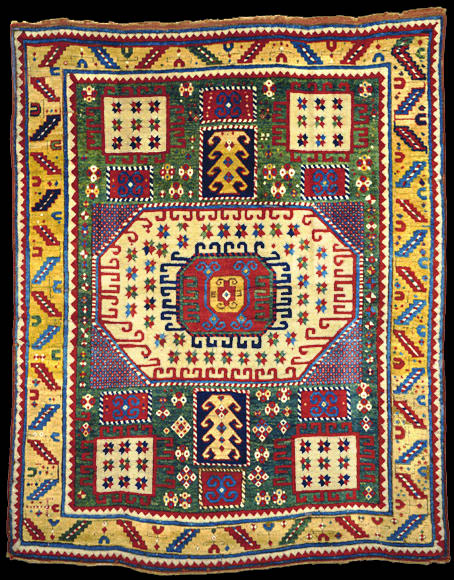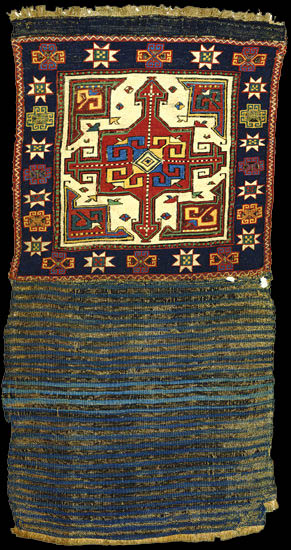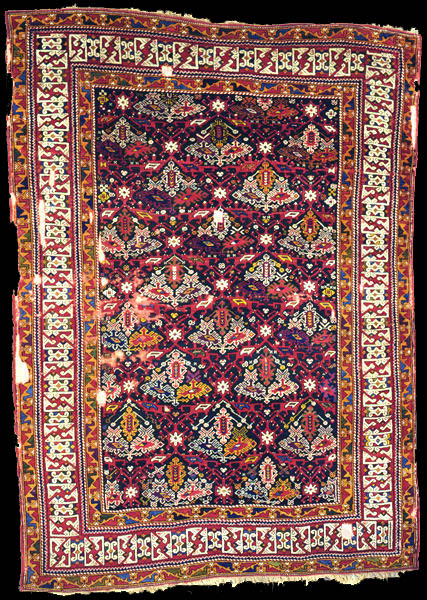CATCH A
FALLING STAR
Herbert J. Exner
Auction Report, 10 November 1999
On 2 October 1999 a significant selection of rugs and kilims from the
Orient Stars Collection were offered for sale at Rippon Boswell in
Wiesbaden. The auction saw a market eager to bid for 'cast-offs' from
arguablym the world's most important rug collection in private hands.
At the 1993 International Conference on Oriental Carpets in Hamburg,
leading carpet collector Heinrich Kirchheim published the highly
influential book Orient Stars, and exhibited his entire collection of
Caucasian and early Anatolian rugs. Kirchheim continued to expand his
collection after this event, making purchases that reflected his growing
predilection for the very rare and the very old; today, the collection
contains at least one weaving that can be dated to the 12th century by
radio carbon analysis. With the emphasis of the collection changing so
significantly, it was inevitable that the collector would look to pass on
his less important or later examples.
The 'cast-offs' included a number of 19th century and earlier Caucasian
rugs and textiles; as with many collections made in Germany, these formed
the starting point for Orient Stars. Kirchheim further pruned the
collection by consigning both the Anatolian kilims and yellow-ground Konya
fragments two groups that perhaps failed to live up to the excellence of
the other weavings. Many of the sale's 84 lots date to between the 17th
and 19th centuries, yet pieces that look out of context in today's Orient
Stars Collection continue to reach the parts of the market that other rugs
can't reach over 70 percent of the lots in the sale found new owners.
In an attempt to get buyers into the right mood, the auction started with
the type-A Star Kazak (1) formerly belonging to Mannheim's Peter Bausback,
who since Eberhart Herrmann's departure from Munich is probably
Germany's premier dealer in oriental carpets. The estimate of DM 180,000
was quickly surpassed in an exchange between two telephone bidders and the
room, with a US buyer winning the day at DM 342,200. This was quite a
reasonable price considering that the Abadjian Star Kazak changed hands
for DM 1 million.
Other 19th century Caucasians included lot 8, a green-ground Karachov with
a beautiful yellow border (2). In perfect condition, the piece was
illustrated in E. Herrmann, Von Uschak bis Yarkand. Seltene Orientteppiche
2 (Munich 1979; pl.15). At that time it had a price tag of DM 85,000, and
here it reached DM 101,480, representing a significant drop in value in
real terms. Another Kazak rug, lot 9, had been previously published, in R.
Tschebull, Kazak (Washington D.C. 1971; pl.2). The irregular shape of its
three octagons and the excellent colour of the green field place this
weaving at the beginning of the 19th century. It sold over the phone for
DM 56,640 just above the DM 50,000 estimate.
Notable amongst the Caucasian flatweaves was lot 14, an Azerbaijan zili
with repeating squares in white, green and two shades of blue. The cover
was in excellent condition and deservedly passed its DM 30,000 estimate to
make DM 33,040. Two Shahsavan bags from the Moghan region in the southern
Caucasus both had popular designs but produced very different results. Lot
15 (cf. two similar pieces in B. Frauenknecht, Schahsavan Sumakh Taschen
(1993, pls.19 and 20) failed to sell, while lot 16 (3), with an arrow gül
and eight-pointed stars in the border, as well as an old-looking striped
kilim back, far exceeded its estimate of DM 24,000, selling for a record
price of DM 46,020.
Of the older Caucasian rugs (i.e. those dating to before 1800), lot 4, was
a really exceptional, perhaps unique, weaving related to the Star Kazak
group (4). In 1984 it had been on the market with Eberhart Herrmann for
less than DM 40,000. This early Kazak, with a red field and two white star
octagons as well as three yellow cartouches, went to a telephone bidder
for DM 66,080 against an estimate of DM 74,000. It can be dated to circa
1800, on account of the similarity of drawing in the cartouche of a rug
dated to 1807 published in J. Eskenazi, Il Tappeto Orientale dal XV al
XVIII Secolo (Milan 1982; pl.156). Lot 23, a white-ground palmette carpet
with a cotton ground (5), was dated to the 17th century. Woven in the
southeast Caucasus or possibly northwest Persia, it has a narrow dark
border with stylised 'curled leaf' motifs which gave the carpet a feeling
of age. The estimate of DM 110,000 was realistic despite some damage in
the pile, but an east Asian bidder in the room managed to get the piece
for DM 80,000.
Anatolian kilims did not have a good day, with most falling short of their
estimates or not selling. First in line was lot 31, a Antalya kilim with a
large number of holes and a high estimate of DM 98,000. Unsurprisingly, it
failed to find a bidder prepared to go higher than DM 50,000 and remained
unsold. A one-piece Nigde kilim (lot 34A) with a striped design and clear
bright colours went to an Austrian buyer for DM 14,160. Lot 38, meanwhile,
a kilim saf from Cappadocia with brilliant colours did not attract a
single bidder in the room. It eventually sold after the sale for DM
35,400, well below its exaggerated estimate of DM 58,000. Best of the
bunch by far was lot 43, a white ground Konya kilim in three pieces (6);
the contrast between the simple field and the ornate compartments of the
borders was lovely.
The infamous Konya fragments provoked differing responses. Occasionally a
deal was closed at half the estimate, but frequently the bidding ended in
provisional sales. Lot 55, a Konya village carpet (7) proved a notable
exception. It showed a bright red, hooked diamond on a golden ground
encompassed by powerful corner spandrels. This rug deservedly sold for DM
50,740, more than doubling its estimate of DM 25,000. However, lot 67, a
red-ground Konya runner fragment (8) fell short of its DM 35,000 estimate,
making only DM 25,960. It had a particularly interesting minimalist design
featuring upright yellow rectangles, each with a blue dot, flanking
tricolour rectangles arranged along the central axis (in
blue/yellow/blue).
Moshe Tabibnia, a Milanese dealer who excelled at this year's
International Conference on Oriental Carpets with his exhibition of early
Anatolian carpets, turned up especially to acquire, among other things,
lot 69, a 17th century Dosemealti described in the catalogue as Dazgiri
(9). It had a Holbein border and a field design related to that found on
Lotto rugs. The final price of DM 40,120 against an estimate of DM 45,000
made his trip to Wiesbaden well worth while.
The Barbieri Tree Carpet, a complete if heavily restored northeast
Persian example from the Safavid period, carried an estimate of DM
480,000, and was arguably the most important offering in the sale. Bidding
did not exceed DM 380,000, and the carpet returned to Stuttgart where it
will remain in a collection that today looks somewhat more refined.
Orient Stars
Rippon Boswell, Friedrichstrasse 45, Wiesbaden, Germany
2 October 1999
|

1. Star Kazak Rug
Central Caucasus, early 19th century
254 x 157cm (8ft 4in x 5ft 2in)
Rippon Boswell, Wiesbaden
lot 1
estimate: DM 180,000
sold for: DM 342,200
|

2. Karachov Kazak
Central Caucasus, first half 19th century
170 x 216cm (5ft 7in x 7ft 1in)
Rippon Boswell, Wiesbaden
lot 8
estimate: DM 100,000
sold for: DM 101,480
|

3. Shahsavan Bag
South Caucasus, 19th century
110 x 56cm (3ft 7in x 1ft 10in)
Rippon Boswell, Wiesbaden
lot 16
estimate: DM 24,000
sold for: DM 46,020
|









